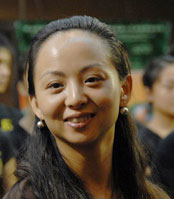 On the afternoon of September 6, Tai Lihua was very busy in the Bird's Nest stadium, doing last-minute preparations for the young dancers in her troupe. That night they were to perform in the biggest show of their lives-the opening ceremony of the 2008 Paralympic Games in Beijing.
On the afternoon of September 6, Tai Lihua was very busy in the Bird's Nest stadium, doing last-minute preparations for the young dancers in her troupe. That night they were to perform in the biggest show of their lives-the opening ceremony of the 2008 Paralympic Games in Beijing.
The dance is special for a very important reason. All the 109 young performers are deaf and mute.
As the leader of the China Disabled People's Performing Art Troupe, Tai calmed anxious nerves, checked costumes, hair ornaments and shoes.
"Believe in yourselves and remember you are the best," Tai said to the young performers using sign language, just before they stepped onto the stage.
The dance, a swirl of arms and hands moving like legs of dancers, was a great success, winning thunderous applause from the audience. Although Tai did not appear in the dance, she still feels excited and proud of her troupe's performance.
"After six months of practice, they presented the audience their best level [of performance] at the opening ceremony. I feel very proud of them," Tai said.
Besides directing the rehearsals of the performances, the 32-year-old Tai also helped with the design of the opening and closing ceremonies of the Beijing Paralympic Games.
"I would tell the director of ceremonies my ideas from the perspective of a disabled person, expressing the thinking of disabled persons," Tai said. She thinks that participating in the performance of the Paralympic Games will greatly advance the development of her troupe.
Former lead dancer
Before taking up the position of troupe director, Tai was a top dancer. Most people know her from the now famous dance The Thousand-Handed Goddess of Mercy, in which she was the lead dancer.
The dance was first performed in public at the closing ceremony of the 2004 Paralympic Games in Athens. All the 21 dancers in the dance were deaf and mute. As they cannot hear the music, these dancers can only perform through reading the hand signs of the dance instructors standing at the four corners of the stage, which makes the precision in performance almost magical. The dance was also a huge hit after it aired on the 2005 Spring Festival gala of CCTV, China's national TV station.
In the dance, the graceful dance movements and Tai's Goddess-like smile held audiences captivated.
"Tai is the best dancer I have ever seen," said Zhang Jigang, director of the dance and also the vice director of the opening and closing ceremonies of the 2008 Olympic and Paralympic Games. "She just has the sense of dance."
But more than her dancing, people are more touched by her spirit, which has helped spread the story of this enchanting woman.
Rescued by music
At the age of 2, Tai lost her hearing after a fever. She did not realize she was different to other children until she was 7 when she was sent to a special school for the deaf and mute.
To a little girl who once owned a beautiful voice, this realization was almost fatal. She was thrust into a deep depression and spent all her time alone. But a music class at the special school totally changed her life.
"Our teacher beat a drum on the floor and I could feel rhythmic vibration passing under my feet over the floor," Tai said when remembering her childhood.
She was totally thrilled by the vibration and bent over the floor to press her face and hands and even her whole body to the floor to feel the vibration and rhythm. Dance and rhythm have become her lifelong friends since then. In the following years, whenever she saw dance performances on TV, Tai would like to press her face closely to the loudspeaker to feel the rhythms of different beats.
When she was 15, she was selected by the China Disabled People's Performing Art Troupe, an unofficial troupe for special art founded in 1987. She was chosen as a dancer and began to receive professional dance training. Through sheer will and hard work Tai made dance her form of expression.
"The only way for me to learn dancing is to remember, repeat, and remember again, until I can feel that a band is alongside me and can play music for me at any time," said Tai. In her eyes, dance is a visible and colorful music and a beautiful language to express her inner world.
The persistence and hard work paid off. She became one of the best dancers of the troupe. Along with other members, she has visited over 50 countries and performed in all the world's leading theaters, including New York's Carnegie Hall and Milan's La Scala Theater. In 2000, a huge poster of her dance The Soul of the Peacock was posted in Carnegie Hall, the first time this had been done for a Chinese performer.